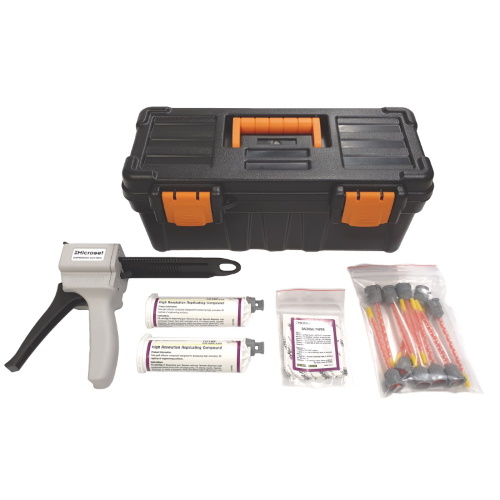Description
Microset Kit 50mL comprising:
1x Applicator Gun
2x Microset 101TH consumable
1x Packet of Backing Paper
10x 50mL Nozzles
1x Carry Case
Replicating with Microset
Surface replication has been employed in engineering for many years, particularly for in situ high resolution metallography. Microset replicating compounds have a resolution better than 0.1 microns, and can be used not only for metallography but also for a multitude of other purposes including 3-D applications.
These specially formulated two-part polymers are supplied in cartridges and dispensed as fully mixed semi-viscous liquids, using simple dispensing guns and mixing nozzles. They cure quickly to produce flexible high resolution replicas which can be peeled from the surface. When viewed microscopically under coaxial illumination, they have a bright metallic appearance, allowing detail such as microstructure, micro-cracking and pitting to be observed at high magnifications. These characteristics make the technique very suitable for the assessment of defects on critical engineering surfaces.
Replicas can be made in any shape or size and, with suitable application methods, the high resolution can be achieved over the whole of the replica surface. Replicas may be removed from surfaces with significant re-entrant detail, without damage, allowing the replication of fracture surfaces, threaded holes, corrosion-pitting, internal geometry, surface mechanical damage, etc. The technique facilitates the detailed inspection of surface features at remote locations inside equipment, where access is difficult. Despite their flexibility when stretched, Microset replicas retain their initial overall geometry and dimensions and are successfully employed both for high accuracy metrology applications, including surface finish and surface damage assessment, and for macroscopic measurements.
Microset replicas pick up loose debris from surfaces and the micro-analysis of such debris can sometimes provide invaluable information, for instance in corrosion related investigations. The benefits of being able to view remote defects microscopically and, where necessary, generate accurate dimensional and analytical information, makes Microset replication a unique, versatile and powerful inspection tool.
Replica Inspection Techniques
A number of different inspection methods may be used to examine and assess Microset replicas depending on the application. Microset replication in combination with these inspection methods allows the qualitative and quantitative three-dimensional characterisation of surface features and defects, in situ.

